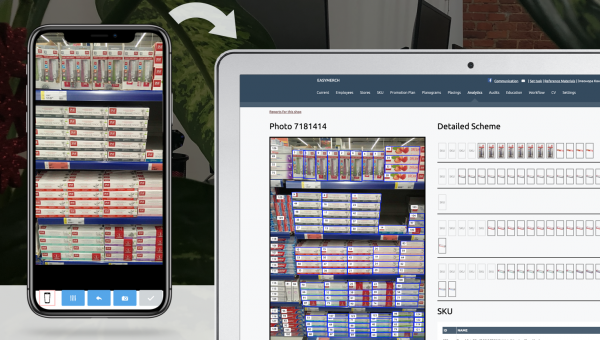Merchandising Made Easier with Image Recognition

Did anybody take a photo of a shelf instead of a door?
Did anybody take a photo of the floor instead of a shelf?
Did anybody just take a photo of their iPad instead of taking the proper photo of a shelf?
You will be the first to know that!
Additional module "Image classifier" automatically recognises the class (type) of the photo and checks if this class of photos is allowed to use with the specific kind of reports or not. The module provides comprehensive analytics for an administrator on the web site and for a supervisor in the app as well.
Why is Image Recognition useful for companies?
Mostly image recognition technology allows you to check on-shelf availability, analyze the shelf share in facings in relation to their competitors, and control compliance with displaying standards. Besides, image recognition may help you:
- Find inactive products on shelves. You will be able to check whether all the products on the shelf are officially produced at the moment, and identify cases of illegal trade.
- Actualize the current matrices (that is, to control compliance and changes). In contrast to merchandisers, the image recognition technology covers all the products, including those outside the matrix.
- Calculate shelf share and on-shelf availability. Thus image recognition makes not only merchandisers’, but also KAMs’ work transparent.
How do you know recognition is working correctly?
Nowadays neural networks are advanced enough to recognize and classify objects on photos successfully. But some factors may lower the success rate. Goods on shelves may be too small, the light may be insufficient, or just an error may occur, and an object will not be recognized (or recognized incorrectly). Here is the solution we provide.
- If a merchandiser during their work notices that some objects have been recognized improperly, they can make a request. Our expert will check it and correct all the omissions manually.
- EasyMerch has its own team of auditors, who constantly work on checking the results of automatic recognition and allows us to guarantee high-quality object recognition.
Modern technologies fall in price with time. Is it true?
Surely, image recognition technologies have fallen in price over the last 5 years. But meanwhile the number of players has increased and the technologies have been highly popularized. That’s why we can say that prices now are at the last stage of formation. A huge part of expenses on neural networks are payments for server resources (neural networks are quite demanding), continuous system enhancement, dataset correction, as well as new product annotation (labeling) and redesign of the existing ones. According to our experience, most vendors tend to redesign about 30% of their products during a year.
Why does image recognition suit not every company?
It may be hard for neural networks to detect and recognize some kinds of products due to the specific form-factor. For example, different kinds of sausages or mascara look quite similar and thus are difficult to be recognized. There may also be some difficulties with recognition of the products in soft packages or bottles of the same design and proportions, but different volume. There is a simple rule: if you can recognize all the objects on the photo by the naked eye, so can the neural networks.
